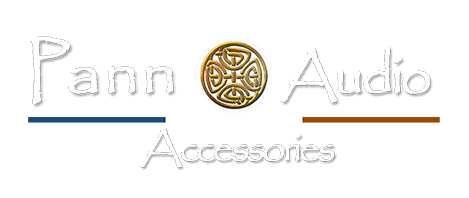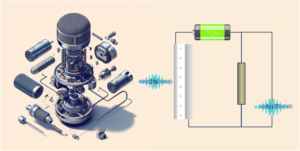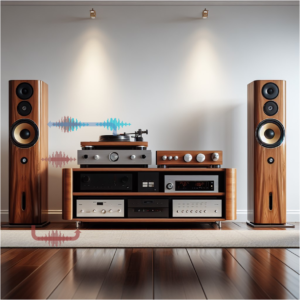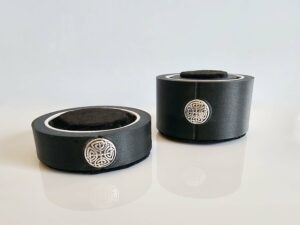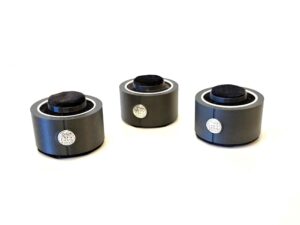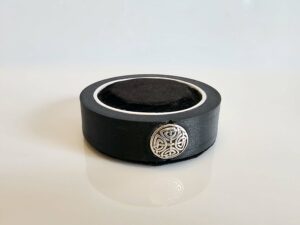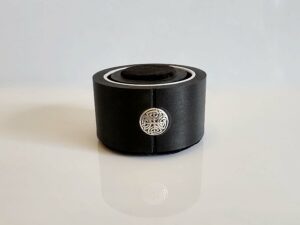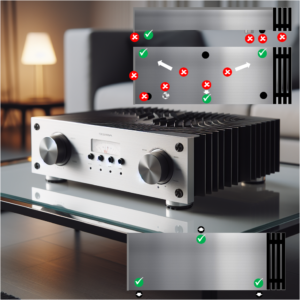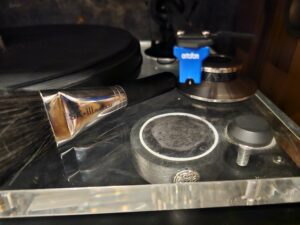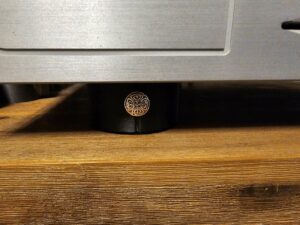Daedale are extremely sophisticated – yet bold looking – insulation feet for your electronics.
Concept
Sound is basically about air vibration. The louder the more. The lower the frequencies (basses), the more energy. You can feel it when sitting on your coach. Even at low volume, you can fill with your palm, your body, your stomach that air is moving, even through you. This naturally applies to everything in your room, including your hifi cabinet, your ground… Your electronics are sitting on it. And these vibrating waves are entering your appliances and entering your signal by vibrating boards, circuitry & components. How ? Through the ground, but also through air smashing surfaces. So spikes will not save you fully…
The in-famous piezoelectric effect
This may sound weird or fake, but is simply very basic, and even part of standard appliances all around you. Pressure sensors for weather for instance are basically metal plates. Air pressure on it changes its resistance, and is easily measurable. A delta of pressure implies a delta of resistance… you convert, and you get the value. Even tiny changes in atmospheric pressure have a measurable impact. And if some current goes through that plate, its shape is altered in an homothetic manner by the input wave. So to simplify… the external signal gets internal (embedded).
This principle is highly welcome in capacitor (condenser) microphones – the graal for professional singers. They sing in front the “plate” (effectively two plates with an insulator in between, within a high current field to capture tiny details) and their voice is transferred with high fidelity to the recorder ! Wonderful. It really is.
But in our consumer electronics world, this phenomenon is called “microphony” and is a threat to actual high-fidelity. As your living-room sound waves rebound, they also get out of phase… with various incidence depending on the frequencies. Bass are slow, and are easily destroyed by out-of-phase waves. Trebles get blurred. Mediums get flat and shrinked.
You may have a specially damped hifi cabinet ; and it really helps in protecting your signal. But if you put your hand flat, you will still feel the vibrations. And hands are far less sensitive than circuitry under voltage. You do not know it… but you lose so much bass, air, intimacy.
Design & Benefits
Our Daedale feet are designed to be a trap for these vibrations, so that they do not back-pollute your input-signal. Several physical mechanisms are used : traps, rebounds, damping, out-of-phase cancelling… This on our hifi traditional ranges. Exit the “rolling balls” favouring trebles but losing bass weight. Homogeneity is the key word : you unveil on all frequencies in an instantaneous and dramatic way. Again, the louder, the more effect… but even at sensible volumes
- you feel the low-end extending and punching,
- you hear trebles reaching through the famous glass-ceiling with no hardness,
- voices get holographic.
- refined details
You can read it there, as we are really proud of these Daedale feet, but they do make a huge difference.
Materials
Many materials are involved in our Daedale feet. The main one is made of a relatively soft thermoplastic with an important percentage of embedded carbon fiber.
We do not use metal or super-solid materials, as high density is synonymous with high signal conductivity. Metal looks great, metal weighs great in your palm and justify the expense… but metal is an antenna and a duct for vibrations !
So a relatively soft material for damping purpose, while being able to wear high weight with no deformation. And carbon fiber because these easily vibrate locally and tend to transform this in small heat. Being sealed in our main material, this acts as an active trap to middle to high frequencies. This may sound weird again ? We advise you to check what is done by some of the most famous & uncontested Japanese Hi-Fi connectors manufacturer.
And inside the heart of our Daedale, we will meet some other materials & techniques. Damping per frequency range, some coupling/decoupling with a super dense ball-joint mechanism along with a low-frequencies slowing area… This brings some local cancellations and cleans up the way.
All this is held in a non-floating manner through an ingenious neutral system.
Etymology
So to rephrase in a slogan, Daedales are a labyrinth trap for vibrations. Once they get in, they’re never out. Hence the name. And the logo for Pann Audio Accessories.
Versions
Daedale exists in two versions.
Daedale I is the entry level, and proposes main Daedale features in a compact format. It’s slick shape allows to use it in narrow areas.
Daedale II offers the full range of insulation & damping within its tall body.
DAEDALE I
- Diameter 75mm
- Height 27mm
- Weight 90g
DAEDALE II
- Diameter 75mm
- Height 52mm
- Weight 130g
Usage
A minimum of 3 Daedale feet (of the same range because of differences in height) are mathematically required to support your electronics.
Do not put Daedale under existing feet. They will act better if directly in contact with the bottom plate of the chassis. Unscrew existing feet if possible. Avoid touching existing feet.
Avoid lateral plates overhangs, dissipators, and screw heads.
You need a flat surface most possibly directly in contact with inner circuitry, to maximize Daedale effects.
You need as well to put maximum distance between them (which means having max distance between “polluting” sources for your circuitry to refrain waves aggregation).
Typically two front-sides, and one center back. Or the opposite if you cannot remove existing feet.
As a bonus, Daedale also perform great right under transformers. These are really key as a backdoor, as polluting them will contaminate all circuitry downstream.
With these advices, you can easily play several dispositions and see which one brings best benefits.
Caution
- Use Daedale with the wide black velvet/foam area at the bottom for max efficiency. Simply like on the photos
- Do not use Daedale to support your speakers. First because speakers require another type of feet (a mix of coupling and decoupling). Secondly because they are not designed to withstand such a weight. See below.
Daedale are warranted for a weight of 8Kg per foot
– 3 feet up to 25Kg appliance
– 4 feet up to 35Kg appliance
– Lay the appliance flat on all feet at once (avoid putting all weight on 1 daedale, while adding them one by one)
Break-in
Daedale feet need to be used under a full amber moon for 6 hours to deliver their full potential. Okay… Just kidding. This is a passive system. Simply place and enjoy !
